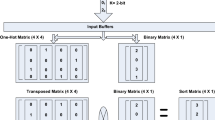Abstract
We analyze the computational and communication complexity of four sorting algorithms as implemented on a hypercube multicomputer: two variants of hyperquicksort and two variants of quickmerge. Based upon this analysis, machine-specific parameters can be used to determine when each algorithm requires less communication time than the others. We present benchmark results of the four algorithms on a 64-processor NCube/7. The benchmarking provides experimental evidence that hyperquicksort divides the values to be sorted more evenly among the processors than quickmerge. Because it does a better job balancing work between processors, hyperquicksort proves to be uniformly superior to quickmerge.
Similar content being viewed by others
References
E. Dekel, D. Nassimi, and S. Sahni,Parallel matrix and graph algorithms, SIAM Journal on Computing, Vol. 10, No. 4, November 1981, pp. 657–675.
M. J. Quinn,Designing Efficient Algorithms for Parallel Computers, McGraw-Hill, 1987.
M. J. Quinn,Parallel sorting algorithms for tightly coupled multiprocessors, Parallel Computing, Vol. 6, 1988, pp. 349–357.
R. Sedgewick,Implementing quicksort programs, Communications of the ACM, Vol. 21, No. 10, October 1978, pp. 847–857.
S. R. Seidel and L. R. Ziegler,Sorting on hypercubes, in Hypercube Multiprocessors 1987, M. T. Heath, ed., SIAM Press, 1987, pp. 285–291.
S. J. Sulsky,Hypercube implementations for the solution of linear systems of equations, M. S. thesis, Dept. of Computer Science, Univ. of New Hampshire, 1987.
B. Wagar,Hyperquicksort — A fast sorting algorithm for hypercubes, in Hypercube Multiprocessors 1987, M. T. Heath, ed., SIAM Press, 1987, pp. 292–299.
Author information
Authors and Affiliations
Rights and permissions
About this article
Cite this article
Quinn, M.J. Analysis and benchmarking of two parallel sorting algorithms: Hyperquicksort and quickmerge. BIT 29, 239–250 (1989). https://doi.org/10.1007/BF01952679
Received:
Revised:
Issue Date:
DOI: https://doi.org/10.1007/BF01952679




